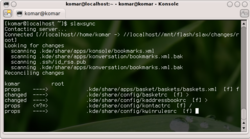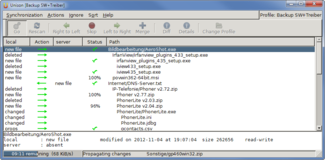Unison (software)
| Unison
|
|
|---|---|

|
|
 Command line version on Linux |
|
| Basic data
|
|
| developer | Benjamin C. Pierce et al. a. |
| Current version |
2.51.2 ( January 27, 2018 ) |
| operating system | Unix derivatives , macOS , Windows |
| programming language | Objective CAML |
| category | Free software for file synchronization |
| License | GPLv3 or later |
| German speaking | No |
| www.cis.upenn.edu/~bcpierce/unison | |
Unison is a free synchronization program for Unix / Linux , Windows , macOS , Solaris and some other operating systems . It synchronizes files between local or remote directories (located on other computers ).
features
Unison has the following features:
- Cross -platform available ( Windows , Linux , Unixe , macOS etc.).
- can handle changes in the file inventory on both sides of replication ; Conflicts (same file changed on both sides) are displayed and can be resolved manually.
- can save the changed files (backup function)
- Synchronization via computer networks (LAN, Internet) by direct connection ( socket ) or tunneled via ssh
- bandwidth-optimized through use of the rsync - algorithm must be transmitted so that only changed blocks of files.
- works as a user level program and does not require a root or Administrator rights
- is fault-tolerant in order to always maintain a consistent state of the replicas even in the event of program crashes or network errors.
functionality
Unison can be called via the command line with parameters or controlled via profile files. It can be executed interactively or automatically in batches. In batch mode, the unique changes are automatically synchronized. Files with replication conflicts are skipped.
After starting, Unison checks the file inventory for each directory or computer and compares the time stamps of the files. If it detects changes, the changes to the corresponding files are analyzed more precisely. Unison then creates a replication list with suggestions for their synchronization and marks conflicts that cannot be automatically resolved.
Examples of usage
- Synchronization of a directory with an external hard drive as a backup.
- Direct comparison of directories between two networked computers.
- Synchronization of directories between one or more computers (Linux, Apple, Windows etc.) with a server.
User interfaces
There are GUI versions from Unison for interactive use . On Windows and Linux they are generally based on GTK + . The GUI versions allow a simpler overview of the replicas and the proposed synchronization. Changes can be noted individually using the keyboard or mouse and then implemented in a group.
restrictions
Unison works on the basis of the local file systems . If replication takes place between different file systems, problems can arise in the following areas:
- File attributes , if they are not supported in the same way by both file systems (example: FAT32 versus POSIX attributes)
- File permissions if they are handled differently (example: NTFS vs. FAT32 vs. Unix file systems).
- File names if their upper / lower case is interpreted differently (example: NAME.TXT, name.txt or Name.txt are three different files under Unix file systems, but one and the same file under FAT32 due to the lack of a distinction between upper and lower case) .
- Symbolic links that are often used, especially in Unix-like systems.
Individual evidence
- ↑ api.github.com . (accessed January 27, 2018).
- ↑ Release 2.51.2 . January 27, 2018 (accessed March 15, 2018).

